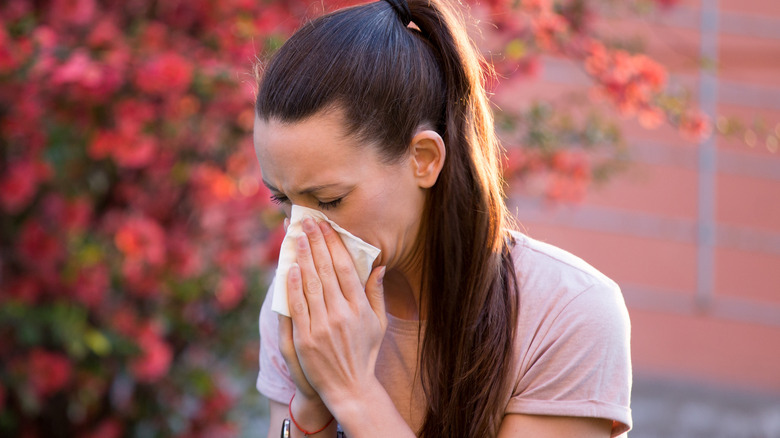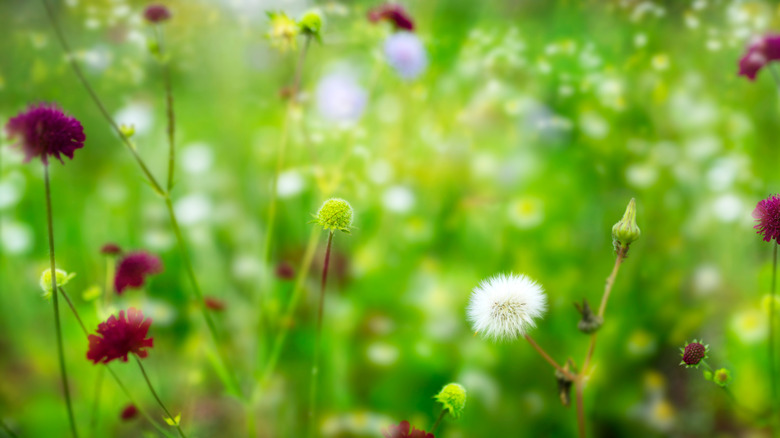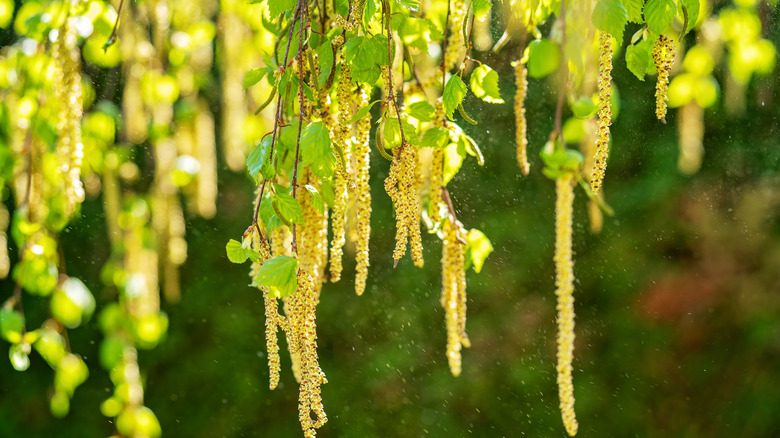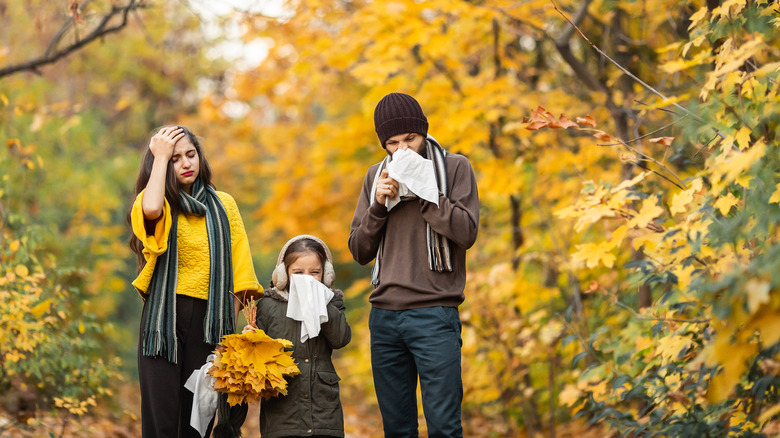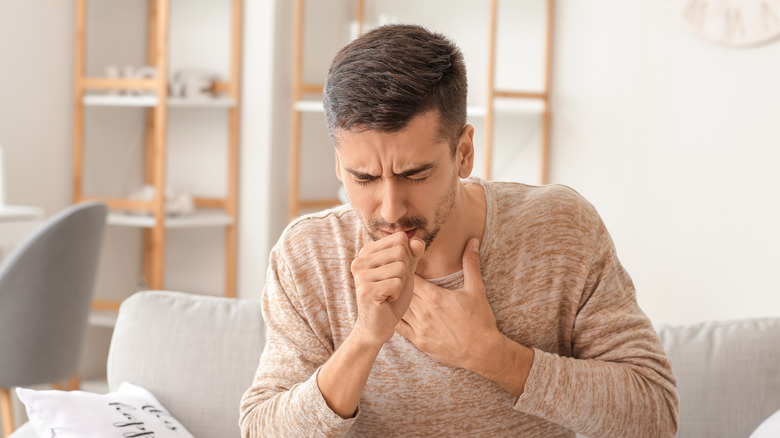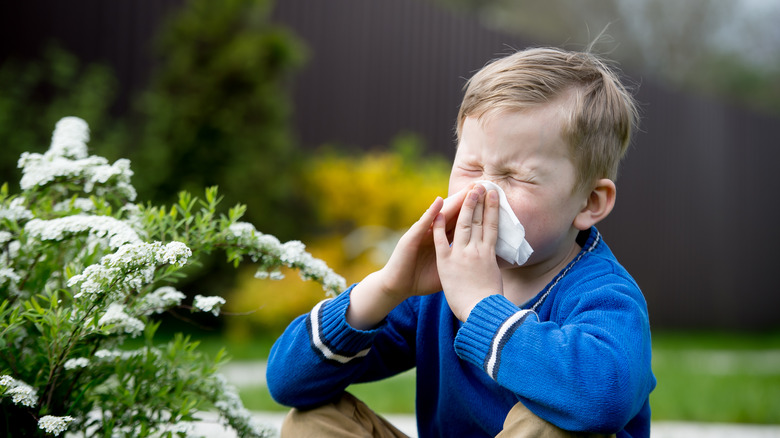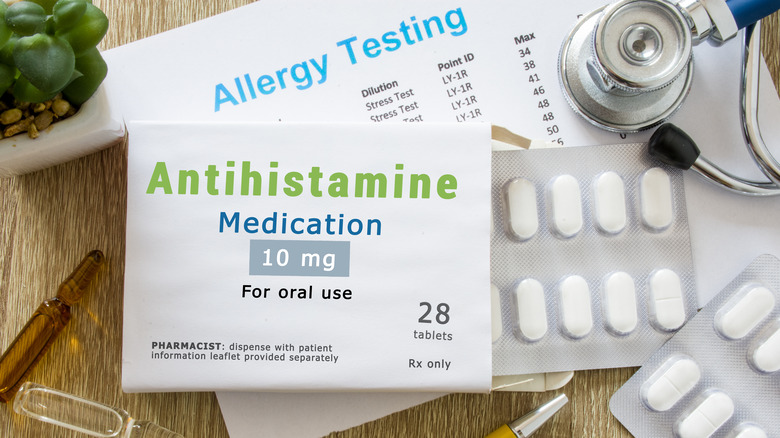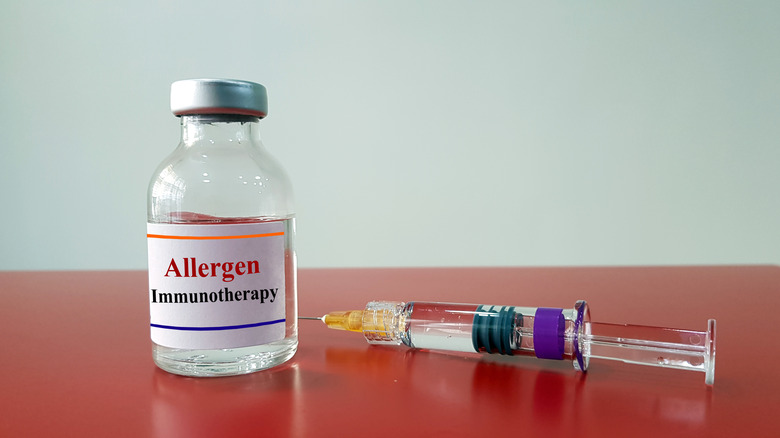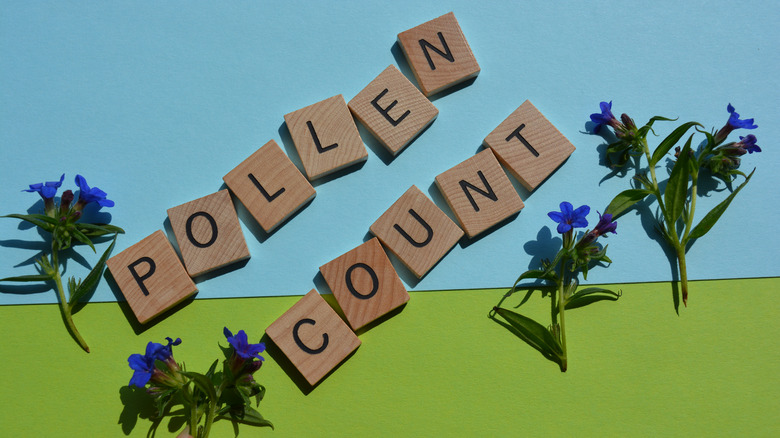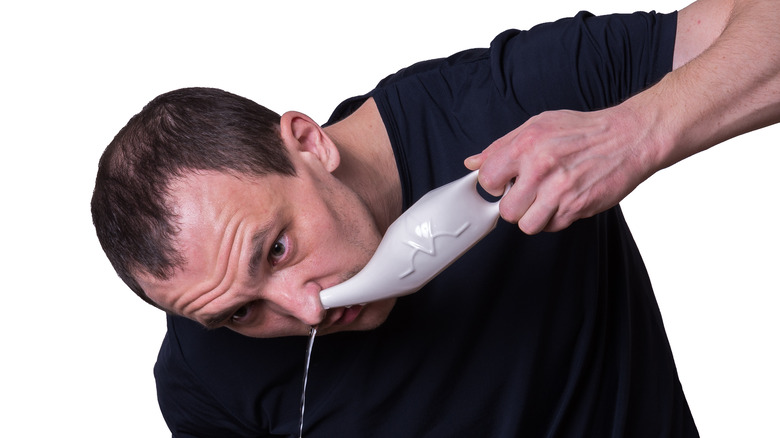Seasonal Allergies Explained: Causes, Symptoms, And Treatments
There's excitement in the air when the seasons change. But for many, a change in seasons can mean a flare-up in seasonal allergies. Allergies plague nearly 60 million Americans per year, according to the Centers for Disease Control and Prevention.
You may be wondering, why am I a seasonal allergy sufferer? Seasonal allergies develop when your body's immune system overreacts to environmental factors during a specific season when certain plants start to pollinate, according to the American College of Allergy, Asthma, Immunology (ACAAI). Your allergies can be better or worse depending on the weather for that year, and on your individual triggers (via Farmer's Almanac). Climate change is also expected to increasingly affect both the length and severity of pollen season (via CDC).
The good news is if you figure out the cause of your seasonal allergies and know the symptoms to look out for, you can find the best treatment option to make changing seasons fun again.
Identifying your allergy triggers
There are ways to prepare yourself for a bad allergy season. If it has been a rainy year where you live or travel, you can probably count on more seasonal allergy issues. "Usually when there is more rain, there is more pollen," Dr. Gary Rachelefsky, staff allergist at Santa Monica-UCLA Medical Center and Orthopaedic Hospital, tells WebMD. Pollen is airborne and can come from grass, flowers, trees, and weeds (via Yale Medicine). It also leads to a condition called hay fever — or allergic rhinitis – affecting millions of adults and children. Hay fever and seasonal allergies are terms that are commonly used interchangeably.
That leads us to the first step in the battle with seasonal allergies: identifying your triggers. Typically, seasonal allergies are caused by pollen from ragweed and mold (via WebMD). Ragweed, in particular, is the most common trigger, as it naturally grows wild everywhere, but can be found in higher concentrations on the east coast and in the midwest regions of the U.S. (via ACAAI). As for mold, you may typically be concerned with mold that grows inside the home, but outdoor mold is also a big allergy trigger. It grows in heavy vegetation, hay, and straw. You also want to avoid diving into a pile of leaves, as outdoor mold is found in raked leaves, according to WebMD.
Allergy triggers by season: spring and summer
In addition to environmental factors near where you live, timing is everything. Spring allergies usually kick off in February with tree pollen and last until early Summer (via ACAAI). If it's a rainy spring, expect plants to be supercharged in growth and outdoor mold to proliferate. The tree culprits vary depending on your location. Birch can be a big allergen for those living in more northerly places, and alder, cedar, horse chestnut, poplar, and willow are also common triggers (via Healthline). Oak trees also cause some spring allergy issues in New England, according to Yale Medicine.
When summer rolls around, the trigger shifts from tree pollen to grasses. Healthline reports that ryegrass, timothy grass, and certain weeds are the big summer allergens. Warmer temperatures mean no relief of grass pollination — something that can last past summer months if you live in a tropical climate (via ACAAI). Ragweed allergies also start rearing their heads in the late summer months.
Allergy triggers by season: fall and winter
When people think of allergy season, it is commonly associated with the fall. Ragweed is the big trigger for this season, as it blooms and releases pollen from August to September, according to the ACAAI. Of those who experience allergic reactions to spring plants, 75% also are sensitive to ragweed (via Zyrtec). "Many people are multi-sensitized, so they are allergic to more than one type of pollen, and they can be symptomatic through all of the warm weather seasons," Yale Medicine pediatric allergist Dr. Stephanie Leeds, says in an article on Yale Medicine's website. Ragweed can also travel through the air for hundreds of miles, ending up in your area even if it doesn't typically grow there.
But it's not just ragweed that causes seasonal allergies to flare up in the fall. Fat hens, mugworts, nettles, and plantains are also big pollen providers in the autumn (via Healthline). Since mold grows in piles of raked leaves, it only makes sense that mold is on the rise in the fall too. And if it gets chilly enough to turn on the heat early, you may feel the effects of dust mites lurking in your furnace, according to Zyrtec.
By winter, outdoor allergens are dormant and provide much-needed relief for those with hay fever symptoms (via Healthline). Indoor allergens like mold or dust mites can still be an issue, but you should get a break before spring allergy season comes.
Seasonal allergy symptoms versus a cold
Part of identifying your triggers and getting yourself treatment is being cognizant of allergy symptoms. Pollen's hay fever can be tricky to identify due to its cold-like symptoms of congestion, cough, sneezing, watery or itchy eyes, runny nose, itchy eyes, sinus pressure and post-nasal drip, and fatigue (via Mayo Clinic). Other symptoms are possible, including wheezing or shortness of breath. These are also signs of asthma, which can be triggered by allergies (via ACAAI).
But how can you tell if you're suffering from a head cold or seasonal allergies? First off, hay fever isn't caused by a virus like a cold is, and even though it has "fever" in the name, you shouldn't run a fever. In contrast, a common cold may come with a low-grade fever, as well as aches (via Emerson Hospital). The timing is also a clue. A cold begins within a few days of virus exposure and lasts anywhere from three to seven days, whereas hay fever will come on quickly and last for the duration of allergy season or allergen exposure.
How to diagnose seasonal allergies
If your allergies drive you crazy enough to head to your doctor, you may want to know what to expect. Doctors typically diagnose allergies in a three-step process. They will first get background information from you to fill out your medical history, then complete a physical exam with a focus on your chest, ears, eyes, nose, skin, and throat, according to the Asthma and Allergy Foundation of America (AAFA).
Generally speaking, diagnosing seasonal allergies may not require a ton of testing if you experience symptoms the same time each year (via Healthline). That is why it is important to try to identify your allergen triggers to help your doctor provide you the best treatment options possible. Your doctor may also suggest a skin prick test to confirm the allergen. In this test, your skin is exposed to a drop of each allergen, then pricked with a needle, according to Merck Manuals. If there is swelling around the area, that means your body is reacting to the allergen. Bloodwork is also a possible diagnostic technique if your skin prick test results are unclear.
Allergies in kids
Allergies don't just affect adults. Children can also experience seasonal allergies at any age, but they usually develop by the age of 10 and peak in the early 20s (via Nemours Kids Health). Those symptoms may start to peter off in adulthood.
In the meantime, seasonal allergies can be particularly difficult for children to manage — and as a result, difficult for a parent to help manage as well. If you are a parent to a child with allergies, you may know that all too well. "A high pollen count day is not going to deter them from going to the playground. That's unlike an adult who might say, 'I'm going to drive my car to work, keep the windows rolled up, and not take that walk during lunch,'" pediatric allergist Dr. Stephanie Leeds tells Yale Medicine. Speak to your pediatrician if you think your child has seasonal allergies. They may refer you to an allergist for testing, diagnosis, and treatment.
Treatment by medication
If you're desperately looking for relief from your seasonal allergies, there is good news: There are tons of allergy medications available in pill or liquid form, as well as nasal sprays and eye drops for those itchy eyes and runny noses. Antihistamines are popular over-the-counter medications that block histamine, which triggers allergic swelling (via AAFA). Antihistamines like Benadryl, Zyrtec, or Allegra focus on calming sneezing, itchy and runny noses, as well as hives.
Many people also take decongestant medications to relieve stuffiness by reducing the swelling in your nose. They come in both oral and nasal spray form. But be warned, if used for longer than three days, decongestants can actually make your symptoms worse via a rebound reaction, according to the AAFA. Consult with your doctor if you think you need to take decongestants for longer. If you struggle with itchy, runny noses and eyes, you can also try nasal corticosteroids — or nose sprays — and mast cell stabilizers in eye drop form or nose spray form.
Sometimes the over-the-counter medications don't seem to do the trick. In these cases, you will want to see your doctor for prescription allergy medication options. "What people don't realize is most of the over-the-counter medicines are designed for milder allergies. For the people who have more moderate to severe allergy problems, it's very rare that over the counter medicines are enough," Dr. James Sublett tells the ACAAI.
Immunotherapy treatments
Some allergy patients turn to immunotherapy treatments if medications don't seem to work or they experience uncomfortable side effects. These options commonly include allergy shots or sublingual immunotherapy (via AAFA). Allergy shot treatments usually run for 3-5 years and consist of injections of a diluted allergy extract that increase over time. Once your body builds tolerance to the allergen, you will experience lesser symptoms, according to the ACAAI. This form of treatment may work well if your allergy triggers are such things as bees, dust, pets, or pollen. It is also helpful for those with asthma (via AAFA).
Sublingual immunotherapy treatments have patients get small doses of the allergen by a dissolvable tablet that is placed under their tongue. This process starts months before allergy season, and treatment can continue for up to three years (via the ACAAI). Sublingual immunotherapy is available for people whose triggers are grass and ragweed pollen, as well as dust mites. As these are common seasonal allergy triggers, sublingual immunotherapy could be a good option for those who want to avoid injection treatments.
Treating allergies with nutrition
Seasonal allergy symptoms may also be alleviated by making changes to your diet. Certain foods like alcohol, chocolate, coffee, peanuts, processed foods, sugar, and wheat are known to provoke hay fever symptoms (via AFC Urgent Care). If ragweed is your allergy trigger, you may also want to avoid bananas, cucumbers, melons, and sunflower seeds. These foods can cause allergic reactions to those with a ragweed allergy, worsening your symptoms. Also, limiting dairy and gluten has been reported to help reduce mucus production, which is beneficial if you're experiencing congestion.
You may have also heard that including dietary supplements, herbs, or probiotics into your diet may help with seasonal allergies. The National Center for Complementary Integrative Health analyzed studies that found that butterbur may be helpful for seasonal allergies. However, they found inconsistent evidence on whether probiotics, honey, grape seed extract, omega-3 fatty acids, capsaicin, and other supplements will have any beneficial effect.
While switching up your diet alone likely won't eradicate your allergy symptoms, it can be part of a multi-step treatment approach to help your season be less sniffly.
Environmental exposure treatment
One of the main ways you can keep seasonal allergies from affecting your daily life is to avoid your triggers and environmental exposures. If pollen is your seasonal allergy trigger, try to limit your activities outside when pollen count is high, or wear a mask, sunglasses, and hat to keep pollen off your body (via AAFA). Ditch any clothes worn outside when you return indoors. You will also want to wash your hair daily before going to bed, and wash your bedding once a week. And don't forget that your pet can also track allergens inside — if they've spent a lot of time outdoors on a high-pollen day, you may want to rinse them off (via WebMD).
You will also want to keep your windows closed on higher pollen days. The American Academy of Allergy, Asthma & Immunology (AAAAI) has a pollen counter that you can use nationwide. If all else fails, get out of town for a bit. "Consider vacations near the ocean or bays," Clifford W. Bassett, MD, AAAAI vice chairman of the Public Education Committee told WebMD. "Pollen counts there are typically lower."
Treatment for indoor exposure
Your allergy triggers may find their way into your home despite your precautions. Or, in cases where your triggers are mold and dust mites, your allergen may be primarily located indoors. If this is your situation, there are some tips that can help. To reduce your exposure to dust mites, use "mite-proof" covers for your bedding, and wash it all frequently (via ACAAI). Clean with a damp rag or mop instead of a broom — this allows you to grab and dispose of allergens rather than pushing them into the air (via Sweeping Dimensions).
Mold can also be the allergy trigger that affects the inside of your home. To keep it at bay, make sure your air conditioning unit is clean and set the humidity between 30 and 50% (via ACAAI). You can go a step further and use a dehumidifier in damper places like your basement. You will also want to clean those damp places more often.
To help keep pollen where it belongs — outside — your can outfit your air conditioning unit with high-efficiency particulate air filters to better trap pollen (via WebMD). Changing out those filters often is also key.
Other non-medical treatment options
There are other non-medical treatment options to help you get through allergy season. You may have heard of using a neti pot to alleviate congestion symptoms (via The National Center for Complementary Integrative Health). This tactic of rinsing your sinuses has mixed reviews, but many swear by it and similar treatments like nebulizers. There is some risk of infection with the neti pot, so you will want to be sure to follow the U.S. Food and Drug Administration's tips on using one safely.
The best preparation may be to start taking allergy medicine before allergy season even begins. Even though it may seem unnecessary, this allows your allergy medicine time to work with your body, preventing it from releasing histamine that cause unpleasant symptoms (via AAFA).
Some people may even consider more extreme measures, such as relocating. But before you go packing your bags to get allergy relief, experts say that moving is a drastic step that may not even help. While foliage that carries mold or pollen can vary from place to place, you may just expose yourself to new allergy triggers (via American Academy of Allergy Asthma and Immunology). If you insist on a change of scenery, be sure to visit for an extended period of time to see if your symptoms actually go away.
When to see your doctor about allergies
Whether you are in denial about your seasonal allergies or one of those people that likes to "tough it out," there may come a point in time when you finally decide to see a doctor for treatment. "I think the problem is that some people have a couple of weeks when they are miserable, and then the rest of the year they are fine, so they think they'll just grin and bear it," pediatric allergist Dr. Stephanie Leeds told Yale Medicine. "But there is a better way. You can take steps to minimize those weeks of misery."
Some tell-tale signs that you need an allergist are if you suffer from symptoms for several months, experience chronic sinus infections or congestion, have asthma flare-ups or are short of breath frequently, and your day-to-day life is greatly affected (via American College of Allergy, Asthma, and Immunology).
